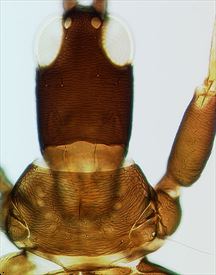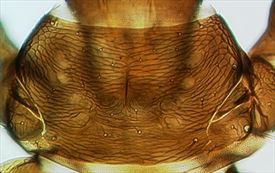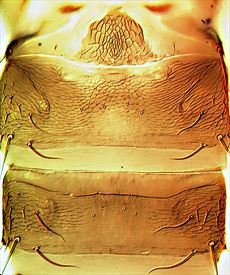Distinguishing features
Both sexes fully winged. Body brown, tarsi and apices of tibiae yellow, also antennal segments III–VII largely yellow, VIII light brown; fore wings pale. Head longer than wide, slightly constricted behind eyes; postocular setae with apices bluntly pointed, scarcely extending to posterior margin of eye; maxillary stylets retracted almost to postocular setae, about one third of head width apart. Antennae 8-segmented; segment III with 1 sense cone, IV with 3 sense cones. Pronotum with strong sculpture pattern; with major setae variable, anteromarginals minute, anteroangulars commonly well-developed, midlaterals and posteroangulars usually much shorter than epimerals; epimeral sutures often not complete. Fore tarsus with small or minute tooth. Metanotum longitudinally reticulate. Fore wing parallel sided, with about 15 duplicated cilia. Pelta broadly triangular; tergites II–VII with two pairs of sigmoid wing-retaining setae; tergite IX setae S1 about 0.8 as long as tube.
Male smaller than female, no fore tarsal tooth; tergite IX setae S2 short and stout; sternite VIII commonly with a pore plate.
Related species
About 40 species are listed in the genus Gynaikothrips, mainly from Southeast Asia. Priesner (1939) gave a key to many species, but there are few studies on variation within and between populations. The genus remains poorly defined, and species recognition is difficult. G. ficorum is the most common species, because its host plant is so widely cultivated. It is usually recognised by the pattern of sculpture on the pronotum, the yellow antennae, and the minute fore tarsal tooth. It differs from G. uzeli in having the pronotal posteroangular setae scarcely longer than the discal setae, whereas the pronotal posteroangular setae of G. uzeli are long.
Biological data
Largely specific to Ficus microcarpa (Moraceae) (Tree et al., 2015), feeding by an adult female on a young leaf induces development of a rolled-leaf or folded-leaf gall. Eggs are then laid within these galls, and substantial colonies may develop.
Distribution data
First recorded in New Zealand (AK) in 2008, but widespread around the world, wherever its host plant is cultivated (Mound et al., 1996).
Family name
PHLAEOTHRIPIDAE, PHLAEOTHRIPINAE
Species name
Gynaikothrips ficorum (Marchal)
Original name and synonyms
Phloeothrips ficorum Marchal, 1908: 252
Leptothrips flavicornis Bagnall, 1909: 529
Liothrips bakeri Crawford DL, 1910: 161
Leptothrips reticulatus Karny, 1912: 22
Gynaikothrips flavus Ishida, 1931: 40
Haplothrips blesai Plata, 1973: 165
References
Mound LA, Wang C-L, Okajima S (1996) Observations in Taiwan on the identity of the Cuban laurel thrips (Thysanoptera, Phlaeothripidae). Journal of the New York Entomological Society 103: 185–190.
Priesner H (1939) Zur kenntnis der gattung Gynaikothrips Zimm (Thysanoptera). Mitteilungen der Muenchner Entomologischen Gesellschaft 29: 475–487.
Tree DJ, Mound LA & Field AR (2015) Host specificity studies on Gynaikothrips (Thysanoptera:Phlaeothripidae) associated with leaf galls of cultivated Ficus (Rosales: Moraceae) trees. Florida Entomologist 98 (3): 880–883.


